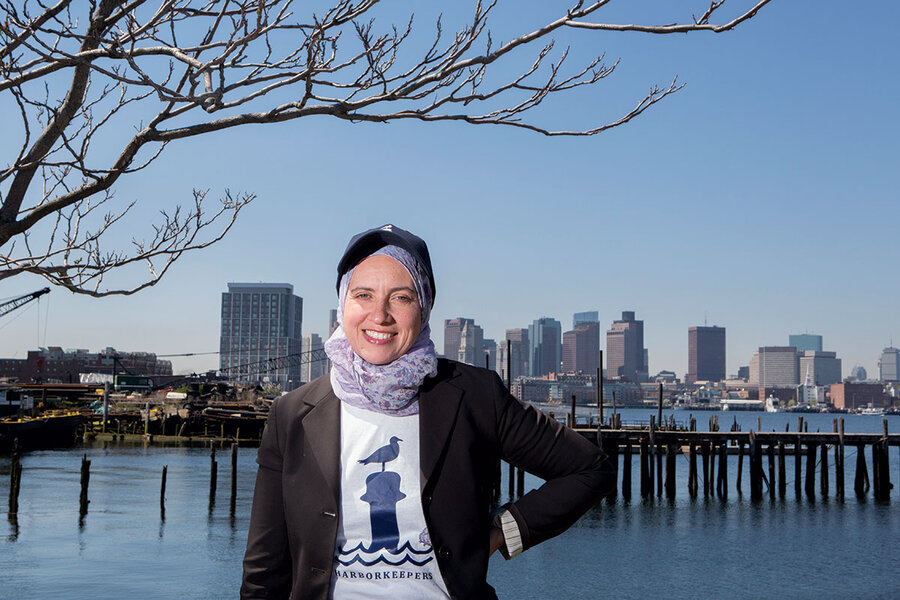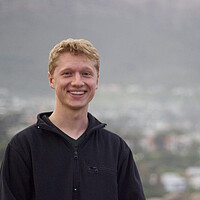How one woman in East Boston shares climate know-how with coastal neighbors
Loading...
| Boston
This year alone, four nor’easters have walloped the Boston region with heavy rain, snow, and storm surges. Here in East Boston, encroaching water has presented notable challenges. And for a variety of reasons, its residents don’t always have access to resources and knowledge to protect themselves, Magdalena Ayed says. So since last year, Ms. Ayed and her nonprofit, Harborkeepers, have been working to lift their neighbors’ environmental consciousness to a new level. Through her work, which includes harbor cleanups, workshops in schools, and live coverage of floods on social media, she’s been raising awareness about the challenges and helping to empower residents as they adapt to a changing environment. For example, at a neighborhood school, Ayed discussed how trash and debris that collect in storm drains can prevent floodwater on the street from dissipating. Then the students went outside to clear the campus. “Magdalena has really brought a lot of attention to the need to clean our harbor, our waterfront, and to be good stewards of the natural resources around us,” says Massachusetts state Rep. Adrian Madaro, whose district includes the neighborhood.
Why We Wrote This
Challenges associated with the environment can often seem bigger than one person can handle. But Magdalena Ayed is showing how each person – schoolchildren included – can have a role in addressing issues.
On a sunny day in early May, Magdalena Ayed leans over the fence above a pebbly beach in East Boston. It looks much better than it did just weeks before, says Ms. Ayed, when she and a group of volunteers cleaned the area of trash. But even so, a few plastic bottles dot the ground, and the sea wall, which protects this neighborhood from the fluctuating tides of Boston Harbor, is leaning precariously out over the lapping waves. “If we didn’t advocate for this [area], it would stay like this for 20, 30 years,” says Ayed, who is the founder and director of Harborkeepers, a local environmental nonprofit.
Like other cities up and down the East Coast, Boston has faced a number of extreme weather events this year. Four nor’easters walloped the region with heavy rain, snow, and storm surges, and high tides have exceeded the harbor’s 12.5-foot tidal level eight times so far in 2018, according to data from the National Oceanic and Atmospheric Administration.
Here in East Boston – a dense, immigrant-heavy community across the harbor from downtown – encroaching water presents notable challenges. The neighborhood is one of the most flood-vulnerable sectors of the city, according to a 2017 study from the Climate Ready Boston initiative. Even under moderate projections for sea level rise, floods with a 1 percent likelihood today are expected to become four to five times as likely in East Boston in the next 50 years.
Why We Wrote This
Challenges associated with the environment can often seem bigger than one person can handle. But Magdalena Ayed is showing how each person – schoolchildren included – can have a role in addressing issues.
But since East Boston is a working-class neighborhood that’s isolated from the rest of the city by the harbor, its residents don’t always have access to resources and knowledge to protect themselves, Ayed says.
So starting last year, Ayed and her nonprofit have been bringing environmental consciousness straight to her neighbors. Through her work, which includes harbor cleanups, workshops in schools, and live coverage of floods on social media, Ayed has been raising awareness about the challenges and helping to empower residents as they adapt to a changing environment.
“Magdalena has really brought a lot of attention to the need to clean our harbor, our waterfront, and to be good stewards of the natural resources around us,” says Massachusetts state Rep. Adrian Madaro, whose district includes the neighborhood. “It gives us an opportunity for East Boston residents to take ownership of our community.”
Ayed, who was born in Argentina and grew up in New Jersey, moved to East Boston 12 years ago. By appearance alone, the community stands out. Streets here are lined with Dominican barbershops and Mexican and Salvadoran restaurants that host late-night mariachi shows.
When Ayed noticed that flooding began to worsen here a few years ago, she looked for opportunities to respond.
And in 2015, Mayor Martin Walsh unveiled the Climate Ready Boston initiative to help the city protect itself against changing environmental conditions. As part of the effort, Boston enlisted community leaders for environmental stewardship training. Ayed joined the group and afterward began incubating plans for a new organization that would bring the city’s momentum on climate advocacy to East Boston, focusing on the neighborhood’s vulnerability – and its potential for collaboration.
“If you’re talking about gentrification, there’s a whole bunch of East Bostonians who are embracing it and a whole other cohort who are concerned about it.... Climate change, though, and extreme weather events and sea level rise, it’s almost like a great equalizer. Everyone is going to be impacted by this,” says Representative Madaro, a Democrat.
Teaching the community
Given the neighborhood’s large immigrant population, East Boston’s schools are a critical place for teaching the community about the environmental health of the waterfront and how to prepare for extreme weather events like flooding, says Elizabeth Thomas, a former school administrator who has lived here for 35 years.
“The schoolchildren often are the ones who are the translators of information to and from their parents,” she says.
Twice a week, beginning in January, Ayed and her colleague Kannan Thiruvengadam, an East Boston resident and director of the nonprofit Eastie Farm, have been visiting local schools to lead workshops on pollution and flooding.
In late March, at the Donald McKay K-8 School, Ayed and Mr. Thiruvengadam opened a workshop with a simple question: “How would you describe Boston’s climate?”
Shouts of “cold,” “rainy,” and “wet” echoed around the room. One girl simply responded “odd.”
The questions turned to recent Boston weather and the storm water that had collected in the parking lot outside. The class refers to it as “Lake McKay.” Ayed then highlighted how trash and debris that collect in storm drains can prevent floodwater on the street from dissipating. Afterward the students, each armed with a trash picker, ventured outside to clear the campus.
Since last year, Harborkeepers has led a series of cleanup initiatives along the wharf to clear storm debris. In 2017, it collected more than 1,000 pounds of trash. This year so far, the figure is close to 650 pounds.
Enthusiasm for the initiatives has been strong. “We went down to one park.... After I left that day I was like, ‘Wow, this is fantastic; we cleaned up this whole park,” says Elizabeth St. Andre, a lifelong resident of the neighborhood. “It made me feel fantastic. Now I’ve been trying to get more involved in the environment.”
Ms. St. Andre isn’t the only resident who has been galvanized by Ayed’s efforts.
“At the beginning people would say, ‘Forget it, you’re never going to get people to come and clean for free,’ ” Ayed says. “And the funny thing is, we’re getting people requesting to come and help us saying, ‘I want my group to come and help clean.’ ” Harborkeepers events, including education efforts and ocean stewardship activities, have reached more than 550 people, she says.
Before major flooding hit Boston on March 2, Ayed posted several videos on social media instructing residents how to prepare their homes for extreme weather. When the storm hit, she recorded the flooded streets and overflowing water drains.
“It is utterly important to document these things because we don’t want to have to rely on others to do it,” she says.
One vulnerable spot along the water’s edge is a parking lot behind Shaw’s, the neighborhood’s sole supermarket. As Ayed traversed through wind and rain that day, she captured a picture of the store’s loading docks inundated with nearly a foot of water.
The reaction from her friends and neighbors was powerful. Now, when the harborfront floods, a network of volunteers is ready to record the scene and tell residents how they can protect themselves.
“Magdalena posts a lot about weather and the storms and what to have for safety kits,” St. Andre says. “And so I was ready.... She’s very precise.” Harborkeepers’s social media platforms, in both English and Spanish, have amassed about 2,000 followers.
Unity and resolve
Many in East Boston are quick to mention how removed they feel from the rest of the city. “We have a community here that is surrounded by water. We are essentially an island,” Ayed says.
But through her work, she has discovered a curious kind of unity and resolve out of that isolation. “We share the flooding. We share the lack of access to the [subway] or whatever it may be,” she says. “We’re all in the same space.”
• For more, visit harborkeepers.org.
Three groups responding to natural disasters
UniversalGiving helps people give to and volunteer for top-performing charitable organizations around the world. All the projects below are vetted by UniversalGiving; 100 percent of each donation goes directly to the listed cause.
• Globe Aware promotes sustainability and cultural awareness. Take action: Volunteer to rebuild roofs that were damaged by hurricane Maria in Puerto Rico.
• Operation USA aids children and families in the wake of natural disasters and other challenges. Take action: Donate money to assist families in Texas who were affected by hurricane Harvey’s flooding.
• SBP, which got its start in St. Bernard Parish in Louisiana after hurricane Katrina, works to reduce the time between disaster and recovery. Take action: Help fund the rebuilding of homes in New Orleans, where a tornado hit last year and Katrina struck in 2005.








